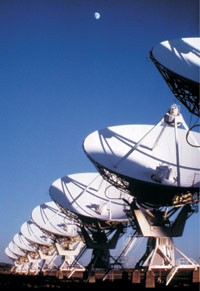| Update, January 2012: The array's new name is the Karl G. Jansky Very Large Array, named after the father of radio astronomy. Jansky was the first to discover radio waves coming from the Milky Way's center. He detected them while searching for sources of static for Bell Labs, which was investigating suitable radio wavelengths for transatlantic telephones. In honor of his observations, Jansky also shares his name with the unit of apparent brightness used by radio astronomers (the Jansky). |

The Very Large Array, a segment of which is shown here, is looking for a new name to go with its second lease on life.
Image courtesy of NRAO / AUI
The upgrade’s goal is to improve all observational capabilities, except for spatial resolution, by at least a factor of 10. The makeover will allow the array to observe everywhere between 1 and 50 GHz (there were some gaps before). Expanding this radio coverage will let astronomers look at a wider range of redshifts, which gives researchers access to different parts of the universe’s history.
There are two options for name submissions: you can suggest a “free form” name — that is, basically anything you can type — or just a prefix to go in front of “Very Large Array.” Entries will be accepted through December 1st and the new name will debut at the American Astronomical Society meeting in Austin this January, where yours truly will be listening.
 4
4
Comments
Cregg
November 22, 2011 at 3:03 pm
Let's at least mention the VLA's location — it's in my state of New Mexico near the town of Socorro! I have visited it and it is stunning to see the whole array up close. They also have a very educational self-guided walking tour open to the public.
You must be logged in to post a comment.
Matthew
November 22, 2011 at 8:31 pm
Sweet to know! I suggested a name of Socorro because of the city its next to.
You must be logged in to post a comment.
Anthony Barreiro
November 25, 2011 at 3:18 pm
ELVIRA - The Extended Large, Very much Improved Radio Telescope Array.
You must be logged in to post a comment.
luribe
November 26, 2011 at 12:47 pm
I just turned in my suggestion: SOCORRO (SOcorro COlaborative Radio aRay Observatory). That works as both a free form and acronym with VLA tacked to the end of it. I'll keep my fingers crossed.
Luis
You must be logged in to post a comment.
You must be logged in to post a comment.